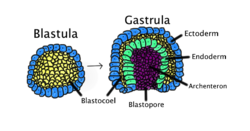
Back Gastrula Afrikaans تكون المعيدة Arabic Гаструляцыя Byelorussian Gastrulacija BS Gastrulació Catalan Gastrulation German Gastrulación Spanish Gastrulatsioon Estonian گاسترولاسیون Persian Gastrulaatio Finnish
| Gastrulation | |
|---|---|
 Gastrulation occurs when a blastula, made up of one layer, folds inward and enlarges to create a gastrula. This diagram is color-coded: ectoderm, blue; endoderm, green; blastocoel (the yolk sac), yellow; and archenteron (the primary gut), purple. | |
| Identifiers | |
| MeSH | D054262 |
| Anatomical terminology | |
Gastrulation is the stage in the early embryonic development of most animals, during which the blastula (a single-layered hollow sphere of cells), or in mammals the blastocyst, is reorganized into a two-layered or three-layered embryo known as the gastrula.[1] Before gastrulation, the embryo is a continuous epithelial sheet of cells; by the end of gastrulation, the embryo has begun differentiation to establish distinct cell lineages, set up the basic axes of the body (e.g. dorsal–ventral, anterior–posterior), and internalized one or more cell types including the prospective gut.[2]
- ^ Urry, Lisa (2016). Campbell Biology (11th ed.). Pearson. p. 1047. ISBN 978-0134093413.
- ^ Gilbert, Scott F.; Michael J. F. Barresi (2016). Developmental biology (Eleventh ed.). Sunderland, Massachusetts: Sinauer. ISBN 978-1-60535-470-5. OCLC 945169933.
© MMXXIII Rich X Search. We shall prevail. All rights reserved. Rich X Search